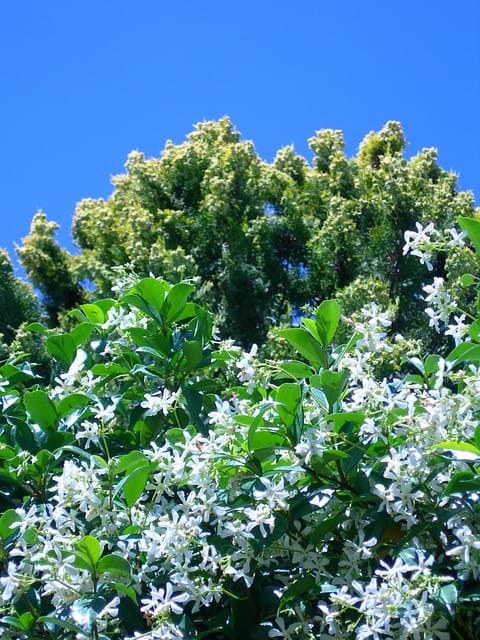How to grow Star jasmine (Trachelospermum jasminoides)
Star Jasmine is a popular climbing vine that is cherished for its fragrant flowers and attractive foliage

In this article:
- Introduction to Star Jasmine (Trachelospermum jasminoides)
- Choosing the Right Location
- Soil and Sunlight Requirements
- Planting Star Jasmine
- Watering and Fertilizing
- Pruning and Training Techniques
- Dealing with Pests and Diseases
- Propagation Methods
- Winter Care and Protection
- Benefits of Star Jasmine in the Garden
- Common Varieties and Cultivars
- Frequently Asked Questions (FAQs)
- Conclusion
Introduction to Star Jasmine (Trachelospermum jasminoides)
The Star Jasmine, scientifically known as Trachelospermum jasminoides, is a popular climbing vine that is cherished for its fragrant flowers and attractive foliage. This evergreen plant is native to China and can be trained to grow against walls, trellises, or fences, making it a great addition to any garden or landscape.
Choosing the Right Location
Star Jasmine thrives in areas with full to partial sun exposure. When selecting a location for planting, it is essential to consider the available space and the support structure, such as a wall or trellis, for the plant to climb onto. Additionally, ensure that the chosen area has sufficient vertical space for the climber to grow to its full potential.
Soil and Sunlight Requirements
Star Jasmine prefers well-draining, fertile soil. It adapts well to a wide range of soil types but thrives in slightly acidic to neutral soils. Before planting, it is advisable to amend the soil with organic matter, such as compost, to improve its overall quality. Regarding sunlight requirements, Star Jasmine prefers full sun to partial shade. However, it can tolerate some shade, making it versatile for planting in various locations.
Planting Star Jasmine
Planting Star Jasmine is relatively straightforward. Follow these steps:
- Dig a hole twice the diameter of the root ball and slightly deeper than its height.
- Gently remove the plant from its container and place it in the hole, ensuring that the top of the root ball is level with the ground.
- Backfill the hole with soil, firming it gently around the plant.
- Water the newly planted Star Jasmine thoroughly.
Watering and Fertilizing
Proper watering is crucial for the healthy growth of Star Jasmine. During the first growing season, it is essential to keep the plant consistently moist. However, once established, it becomes relatively drought-tolerant and only requires watering during extended periods of dry weather. As for fertilizing, use a balanced, slow-release fertilizer in spring to provide sufficient nutrients for the plant's growth.
Pruning and Training Techniques
To maintain a neat and well-shaped appearance, Star Jasmine requires regular pruning. Pruning can be done after the blooming period, typically in late spring or early summer. Remove any dead or damaged branches, and trim back excessive growth to encourage bushier growth. Additionally, this climber can be trained to climb a trellis or wall by gently tying the stems to their support using soft plant ties or twine.
Dealing with Pests and Diseases
Star Jasmine is generally a sturdy plant with good resistance to pests and diseases. However, it can occasionally attract spider mites, aphids, and mealybugs. Regularly inspect the plant for any signs of infestation and treat accordingly with organic or chemical insecticides. To prevent diseases, ensure proper air circulation around the plant and avoid overwatering.
Propagation Methods
Star Jasmine can be propagated through various methods, including stem cuttings, layering, and seed germination. The most common and reliable method is taking semi-ripe stem cuttings in early summer. Prepare a rooting hormone to dip the cuttings in, plant them in a well-draining soil mix, and keep them in a warm and humid environment until roots develop.
Winter Care and Protection
In colder climates, Star Jasmine may require some winter protection. Mulch around the base of the plant to insulate the roots and protect them from freezing temperatures. If possible, cover the plant with a frost cloth or burlap during severe winter conditions. Pruning should be minimal during winter, as it may stimulate new growth that is vulnerable to frost damage.
Benefits of Star Jasmine in the Garden
Star Jasmine offers several benefits in the garden, including:
- Fragrant flowers that fill the air with a delightful scent.
- Attractive foliage that remains evergreen throughout the year.
- The ability to create a beautiful, living wall or screen.
- A habitat for pollinators, such as bees and butterflies.
Common Varieties and Cultivars
There are several popular varieties and cultivars of Star Jasmine, including:
- Trachelospermum jasminoides 'Variegatum': A variegated variety with leaves featuring creamy white edges.
- Trachelospermum jasminoides 'Madison': Recognized for its larger and more fragrant flowers.
- Trachelospermum jasminoides 'Star of Toscana': A compact variety suitable for smaller spaces.
Frequently Asked Questions (FAQs)
Q: Can Star Jasmine grow indoors?
A: Star Jasmine can be grown indoors in suitable conditions, such as a bright room with ample sunlight and sufficient space for the climber to grow.
Q: How fast does Star Jasmine grow?
A: Star Jasmine is considered a moderately fast-growing climber, with an average growth rate of about 12-24 inches per year.
Q: Does Star Jasmine attract bees?
A: Yes, Star Jasmine flowers are highly attractive to bees and other pollinators.
Conclusion
By following the guidelines outlined in this article, you can successfully grow and care for the Star Jasmine climber (Trachelospermum jasminoides). Enjoy its fragrant blossoms, lush foliage, and the beauty it adds to your garden or landscape.
